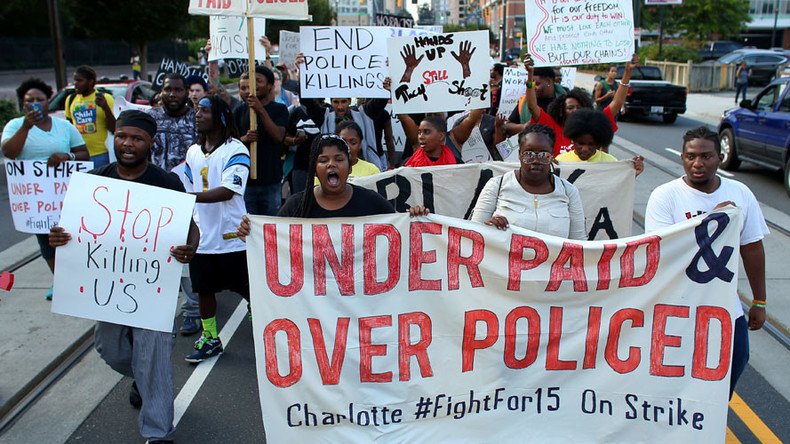Poor data fuels idea ‘biased US police are killing black men at epidemic rates’ – FBI chief

Lack of data fuels idea that ‘biased US police are killing black men at epidemic rates’ – FBI chief
The FBI director said the absence of reliable data about how often police use force contributed to a regrettable narrative that “biased police are killing black men at epidemic rates.”
“It is a narrative driven by video images of real and gut-wrenching misconduct, by images of possible misconduct, by images of perceived misconduct,” Comey said at a conference of international chiefs of police on Sunday, according to AP. “It’s a narrative given force by the awesome power of human empathy.”
FBI's James Comey: “Americans actually have no idea” about how often police use force. U.S. needs more/better data: https://t.co/qFNFwuTn9U
— The Marshall Project (@MarshallProj) October 17, 2016
Comey said those videos of fatal police encounters that capture the public’s attention and are shared broadly across the internet can fuel the perception that “something terrible is being done by the police,” even if the data aren’t there to back it up.
Americans “actually have no idea if the number of black or brown or white people being shot by police is up, down or sideways over the last three years, five years, 10 years,” or if black people are more likely than white people to be shot during police encounters, Comey said.
“In the absence of information, we have anecdotes, we have videos, we have good people believing something terrible is happening in the country,” he said. “In a nation of almost 1 million sworn law enforcement officers, and tens of millions of police encounters every year, a small group of videos serves as proof of an epidemic.”
Video footage of the police-involved death of Eric Garner on Staten Island in June 2014 prompted massive protests in New York. The police shooting of Michael Brown in Ferguson, Missouri, in August 2014 prompted a week-long protest and vigil before descending into rioting that led to burned-out businesses. In April 2015, vigils and protests erupted into two days of rioting over the death of Freddie Grey in police custody in Baltimore before the governor declared a state of emergency. In July 2016, the shooting death of Philando Castile, where his girlfriend recorded her reaction and interaction with police moments after he was shot, led to a week of protest and vigil before descending into a riot lasting two days.
HAPPENING NOW: Riot police shoot rubber bullets at #PhilandoCastile protesters in #Minnesota - reports https://t.co/tShY6Qa4Yn
— RT America (@RT_America) July 8, 2016
Comey’s comments somewhat surprisingly contradict the findings of the Justice Department’s own investigations into police department misconduct across the nation.
In August, the Justice Department, after reviewing data from 2010 to 2016, found the Baltimore Police Department engaged in unconstitutional practices that lead to disproportionate rates of stops, searches and arrests of blacks, and excessive use of force against juveniles and people with mental health disabilities.
Among the findings:
• African-Americans accounted for 95 percent of 410 individuals stopped at least 10 times from 2010 to 2016
• One African-American man in his 50s was stopped 30 times in less than four years; none of the stops resulted in a citation or criminal charge
• African-Americans accounted for 82 percent of all BPD vehicle stops though they make up 60 percent of the driving age population in the city and 27 percent percent of the driving age population in the greater metropolitan area.
Baltimore police conducted more than 60 illegal strip searches, some in public - DoJ https://t.co/xRNxlAu0aJpic.twitter.com/RamRBdPMVn
— Alex Tanasie (@dookyyy) August 12, 2016
The Justice Department made similar findings for police departments in Newark, New Jersey, St. Louis, Missouri, and Albuquerque, New Mexico.
@danthegreater here's one that's national https://t.co/rayVKKKJWn
— Christine McNichol (@Fieryreddragon) August 31, 2015
Comey did admit “There are bad cops. There are departments with troubled cultures. Unfortunately, people are flawed. But for law enforcement, the spotlight is brighter, and the standards are higher. And that’s the way it should be.”
Another protest descended into a riot between September 20 to 22, in Charlotte, North Carolina, as people protested the fatal shooting of Keith Lamont Scott, a black man, who police alleged was carrying a gun after video was released. A protester was shot and killed during the demonstrations.
“Each video becomes further proof of an epidemic nationwide of police brutality. Our officers see the videos. They desperately do not want to be in one. They think about that all the time,” said Comey.
He added that the narrative makes the gap between police and the community worse.
The Justice Department said last week it would start collecting data on police shootings, and Comey said a database was critical in helping the police improve public perception of officers and “closing a chasm of distrust and fear.”
“We need to collect actual, accurate and complete information about policing in this country so that we have informed debates about things that matter enormously,” Comey said. “Our officers see the videos. They desperately do not want to be in one. They think about that all the time.”












